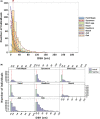A comparison between data requirements and availability for calibrating predictive ecological models for lowland UK woodlands: learning new tricks from old trees
- PMID: 27547315
- PMCID: PMC4979709
- DOI: 10.1002/ece3.2217
A comparison between data requirements and availability for calibrating predictive ecological models for lowland UK woodlands: learning new tricks from old trees
Abstract
Woodlands provide valuable ecosystem services, and it is important to understand their dynamics. To predict the way in which these might change, we need process-based predictive ecological models, but these are necessarily very data intensive. We tested the ability of existing datasets to provide the parameters necessary to instantiate a well-used forest model (SORTIE) for a well-studied woodland (Wytham Woods). Only five of SORTIE's 16 equations describing different aspects of the life history and behavior of individual trees could be parameterized without additional data collection. One age class - seedlings - was completely missed as they are shorter than the height at which Diameter at Breast Height (DBH) is measured. The mensuration of trees has changed little in the last 400 years (focussing almost exclusively on DBH) despite major changes in the nature of the source of value obtained from trees over this time. This results in there being insufficient data to parameterize process-based models in order to meet the societal demand for ecological prediction. We do not advocate ceasing the measurement of DBH, but we do recommend that those concerned with tree mensuration consider whether additional measures of trees could be added to their data collection protocols. We also see advantages in integrating techniques such as ground-based LIDAR or remote sensing techniques with long-term datasets to both preserve continuity with what has been performed in the past and to expand the range of measurements made.
Keywords: DBH; SORTIE; Wytham Woods; ecological forecasting; forestry; predictive models.
Figures


References
-
- Ameztegui, A. , and Coll L.. 2011. Tree dynamics and co‐existence in the montane‐sub‐alpine ecotone: the role of different light‐induced strategies. J. Veg. Sci. 22:1049–1061.
-
- Ameztegui, A. , Coll L., and Messier C.. 2015. Modelling the effect of climate‐induced changes in recruitment and juvenile growth on mixed‐forest dynamics: the case of montane‐subalpine Pyrenean ecotones. Ecol. Model. 313:84–93.
-
- Anderson‐Teixeira, K. J. , Davies S. J., Bennett A. C., Gonzalez‐Akre E. B., Muller‐Landau H. C., Joseph Wright S., et al. 2015. CTFS‐ForestGEO: a worldwide network monitoring forests in an era of global change. Glob. Change Biol. 21:528–549. - PubMed
-
- Bose, A. K. , Harvey B. D., Coates K. D., Brais S., and Bergeron Y.. 2015. Modelling stand development after partial harvesting in boreal mixedwoods of eastern Canada. Ecol. Model. 300:123–136.
-
- Botkin, D. B. 1993. Forest dynamics: an ecological model. Oxford University Press, New York, NY.
LinkOut - more resources
Full Text Sources
Other Literature Sources
Miscellaneous

